Pico Island, The Azores, August 2024
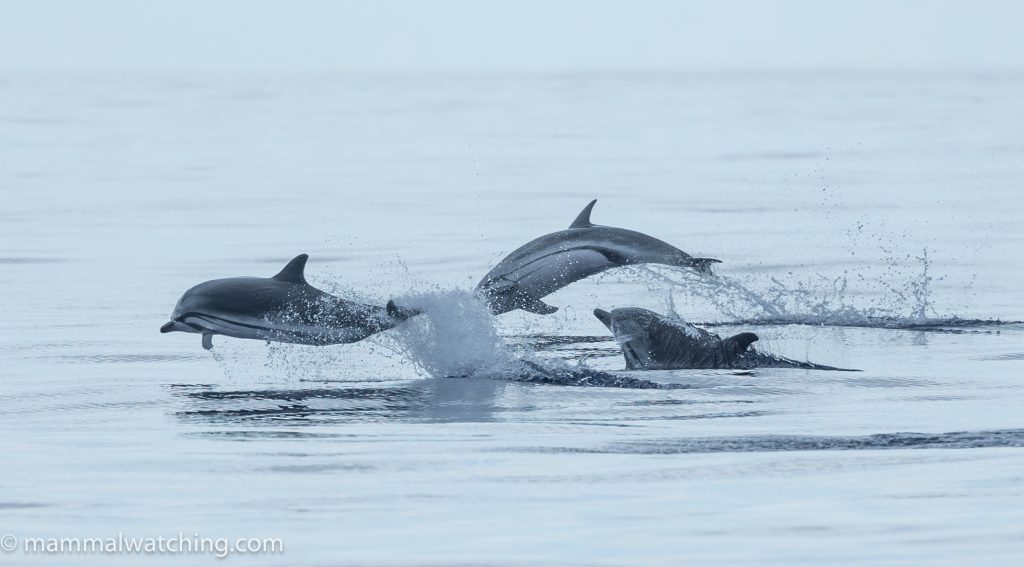
Striped Dolphins (Stenella coeruleoalba)
“Let’s go to the Azores. I mean I do quite like whalewatching….” I looked deep into Zoom and searched for any hint of sarcasm in my daughter’s expression. She seemed serious.
She also seemed sober but on reflection I have my doubts. Three months later she vehemently denied this conversation took place. But back in May, when we had been talking about our options for a summer trip, Katy had voted for the mammalwatching one. And I had made no attempt to question her judgement or sobriety.
The Azores had been on my Bucket B-list for a while. They moved up a few places after cetacean guru Todd Pusser flagged them as a good place to see Sowerby’s Beaked Whales, after I complained to him that I had missed on two 24 hour pelagic trips out of New York City. That was the carrot.
The stick was that Alex Myer’s two year old daughter, Ava, was now a mammal up on me after seeing Azores Noctule there in the spring.
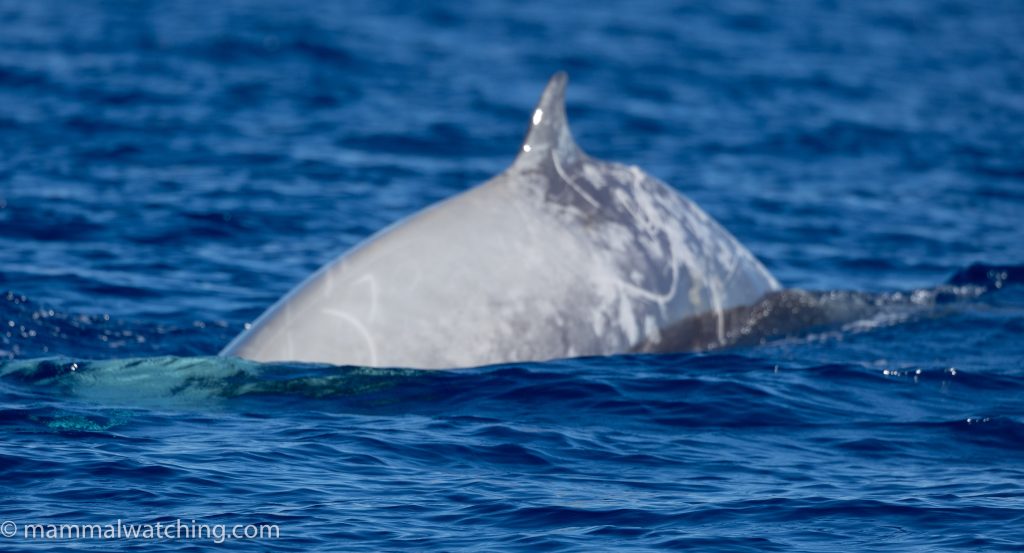
Cuvier’s Beaked Whale (Ziphius cavirostris)
Svalbard cruise companions Jonas Livet and Ruta Vaicekauskaitė were keen to join Katy and me. We met on Pico Island in mid-August for a few days whalewatching.
Pico Island
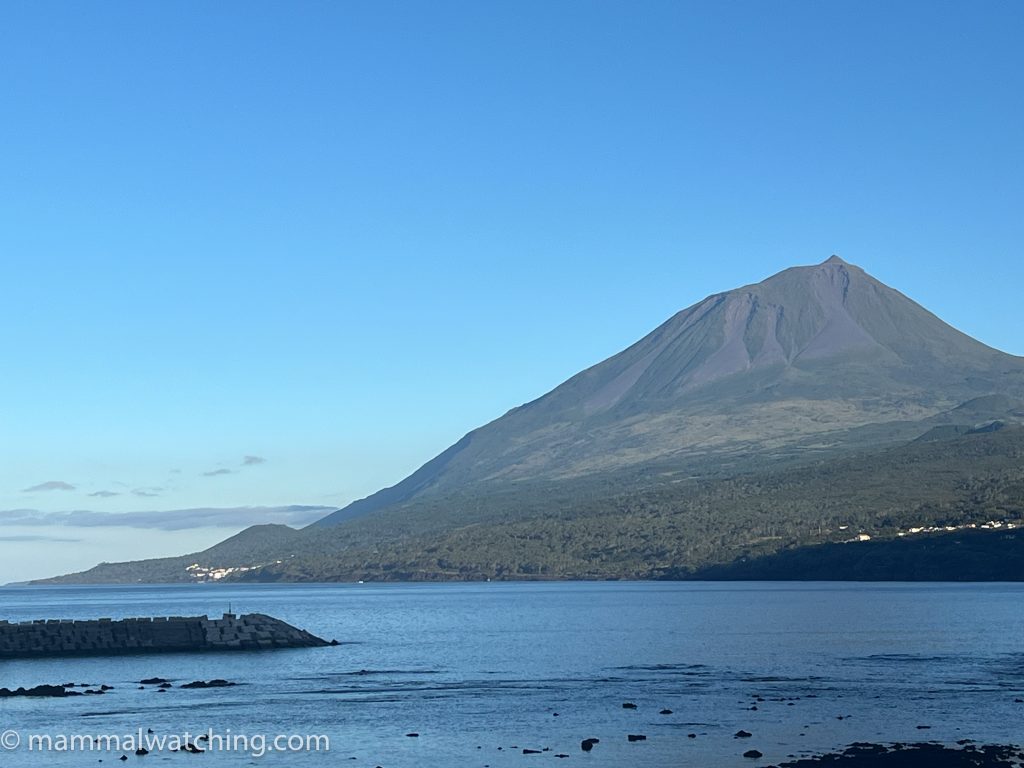
The Azores had a signifiant whaling industry which only shut down in the late 1980s. In 2024 the whalewatching industry seemed to be thriving. Multiple boats were leaving our small village, Lajes do Pico, every day and Lajes is just one of several whalewatching bases on Pico Island, and Pico one of several islands. There are options of where to whalewatch on the Azores. I had several recommendations to go out with the whalewatcing company Espaco Talassa on Pico Island. This was very good advice. And so I chose Pico Island because of Espaco Talassa, rather than vice versa.
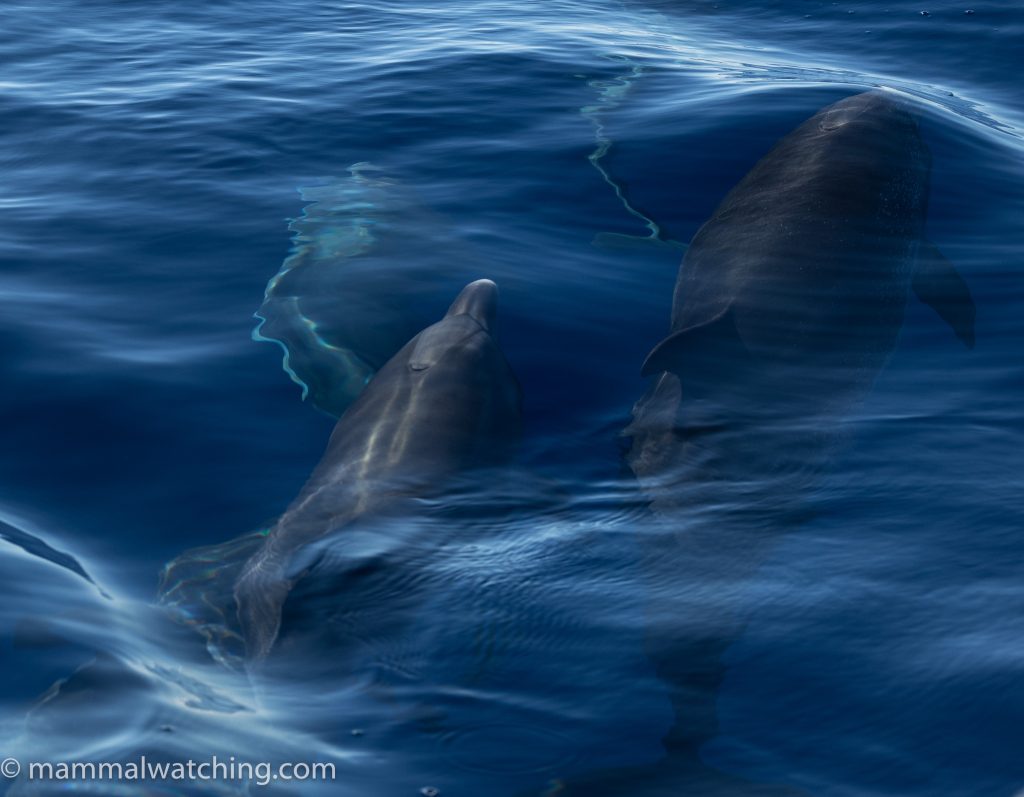
Atlantic Spotted Dolphin (Stenella frontalis)
Adam Walleyn connected me with his friend Hella Martens, who had spent five seasons working as a guide for Especial Talassa. She gave me some good advice and encouraged me to connect via Instagram with Espaco’s most experienced Captain, Joao Quaresma. More on Joao later but he is a super nice guy and I am sure it helped our beaked whale quest that we let him know in advance how excited we were about finding the more obscure species.
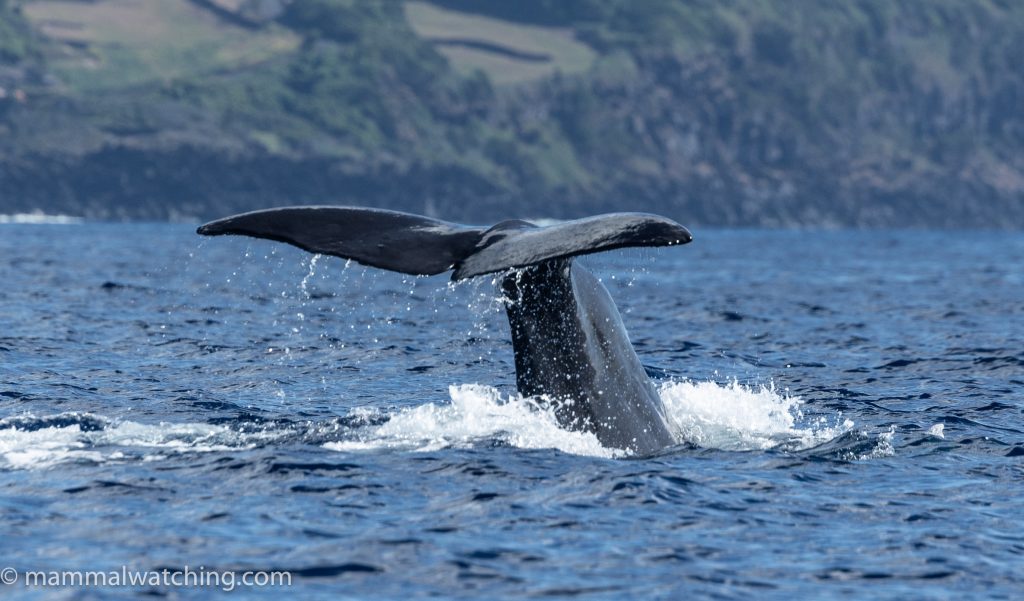
Sperm Whale (Physeter macrocephalus)
The whalewatching season runs from April – October. There is some useful data on sightings here that shows how species composition changes through the seasons. In a nutshell, many dolphin species and Sperm Whales are present through the year. April and May is the time for Blue Whales and other large baleen species. While the summer is better for beaked whales.
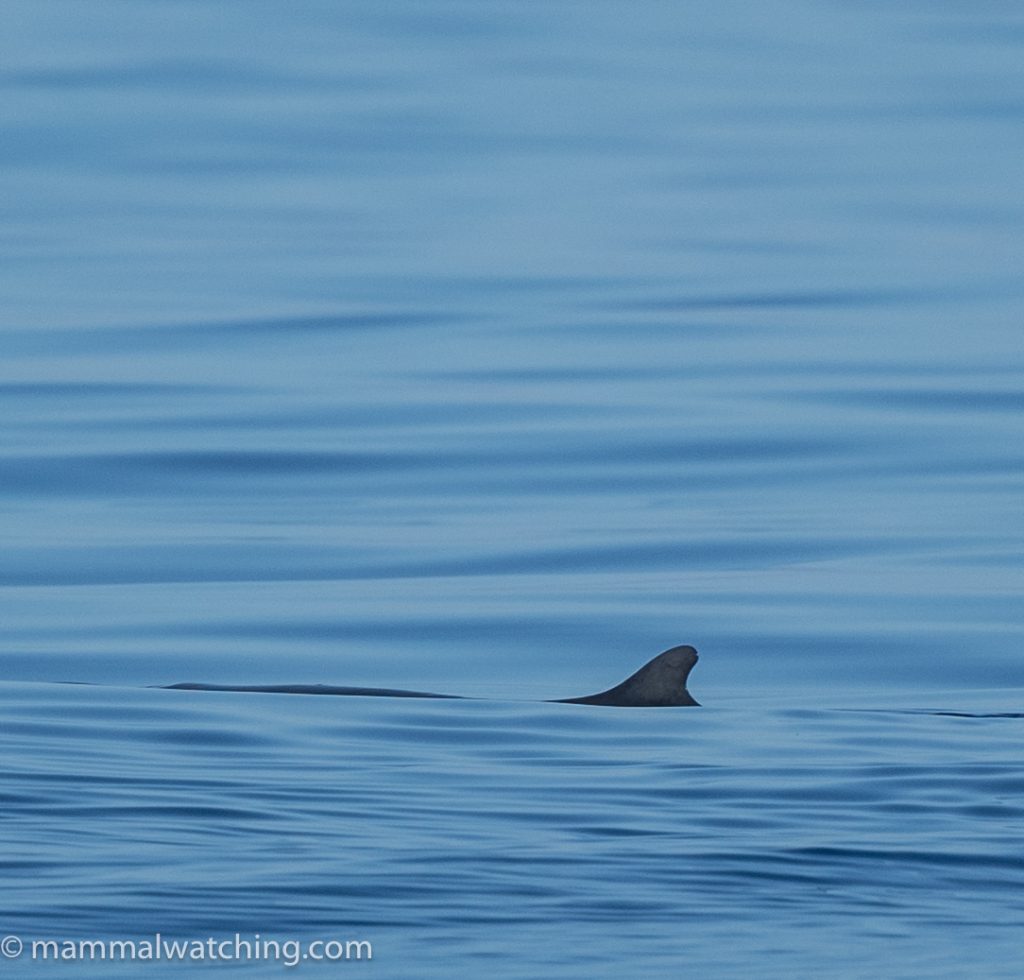
Pygmy Sperm Whale (Kogia breviceps).This is about as much as you usually see of either kogia species. Little wonder they are rarely seen outside of flat calm seas.
The other big determinant is the weather, which is harder to predict. Beaked and Pygmy Sperm Whales are not only uncommon summer visitors, they are very difficult to spot in anything other than near perfect conditions. We were very lucky to have had those perfect conditions throughout our stay.
Where To Stay, Where To Eat
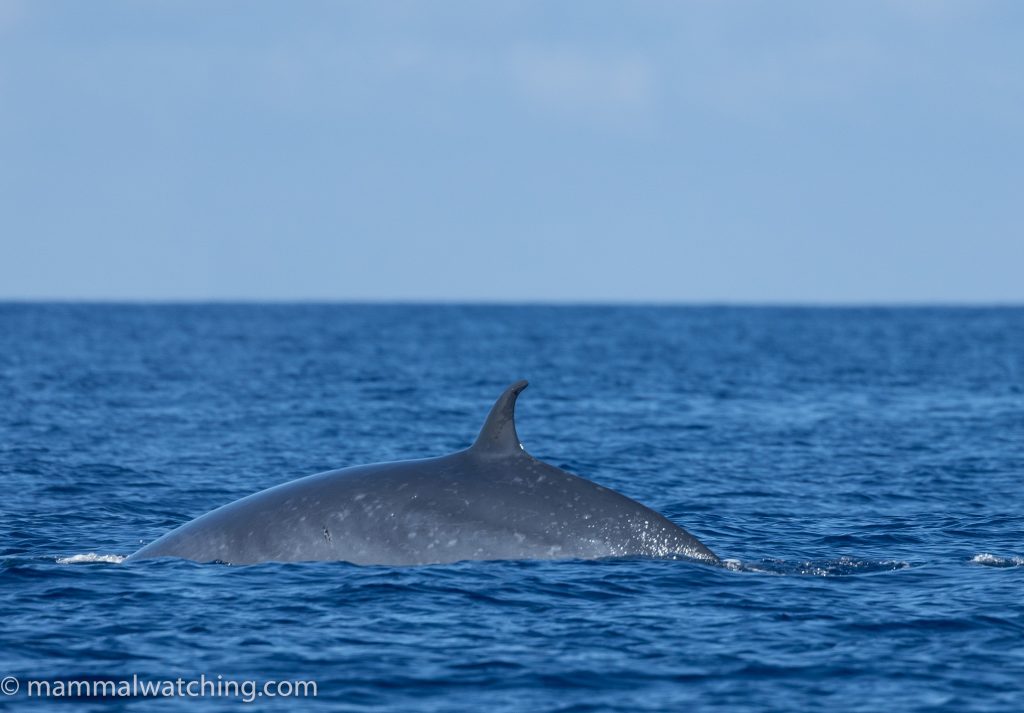
Bryde’s Whale (Balaenoptera brydei)
We arranged this trip less than three months in advance. And I put all my energy into thinking about the whale watching rather than accommodation options. Sorry Katy. We stayed at Espaco’s Whale’come Ao Pico Hotel. It was convenient – next to the whalewatching offices – but I imagine there is better accommodation in Lajes. Our room was small – like Paris hotel room small – and without AC. It was unpleasantly hot. Now I gather AC is not usually needed on Pico unless, like us, you stay during a heatwave. So while I would 100% recommend using Espaco for your whalewatching you might want to check out Airbnb and other options for accommodation.
There are direct flights from New York and Boston to Ponta Delgada in the Azores. It only takes 6 hours. I assumed it would be easy to fly or ferry between the islands. I assumed wrong. So, unlike me, you might want to check connections before you book your international flights. Luckily I discovered my mistake within the 24 hour free cancellation window and flew direct to Pico from Lisbon.

There are plenty of places to eat in the village but it took a while to find the best ones. Our two favorites were a tiny outdoor sushi restaurant – Mar Terrace Sushi Agua – a few hundred metres north of the harbor, and a bakery on the village main street which was perfect for breakfast and good coffee before the 9 am boat.
The Whalewatching
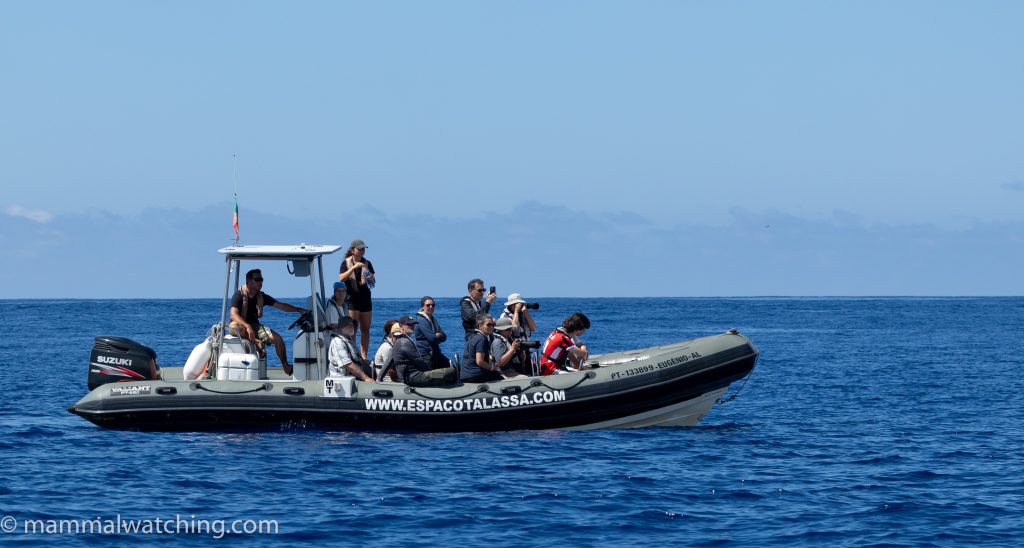
Espaco Talassa run a three hour trip every morning and another every afternoon. They occasionally offer a sunset trip too. And they had four or five boats on the water for each trip. Business is booming!
We had to book and pay for at least some of our whalewatching in advance order to be able to reserve a room at the Espaco hotel. I would have preferred to have chosen my trips a day or two in advance once I had seen the weather forecast. But many of the boats are sold out several days beforehand. So I took a chance and booked four trips a month in advance. Though the company seemed a bit inflexible about bookings over email, when I was there it was a different story. They didn’t mind me switching bookings (repeatedly) from one trip to another. They could also put us on a wait list when boats were full. I do not know what might have happened if I had moved from one trip to another and my original seat was not filled. I guess that didn’t happen and it all worked out fine. I went out 6 times.
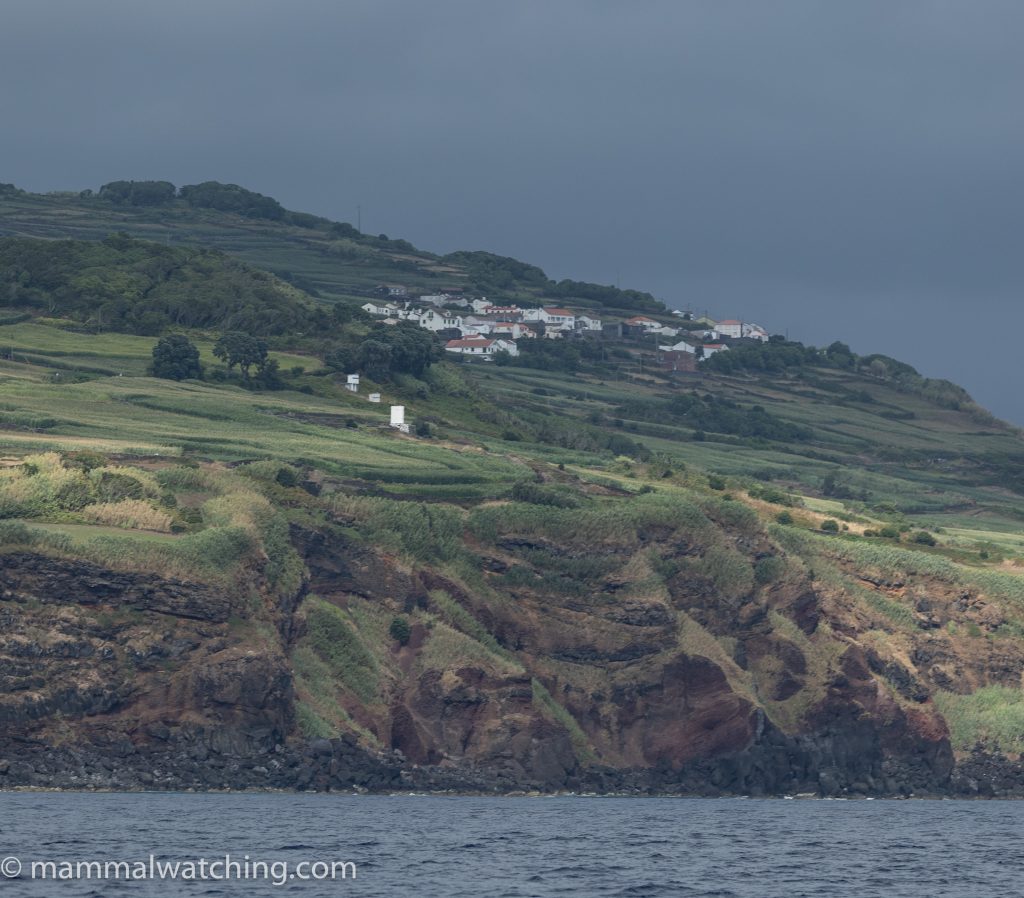
The Vigia Tower
The whalewatching is exceptionally good both for the diversity of species and numbers of animals. We saw at least six species of cetacean on every trip and one – record breaking morning – saw 10 species in three hours. This was exceptional for Pico!
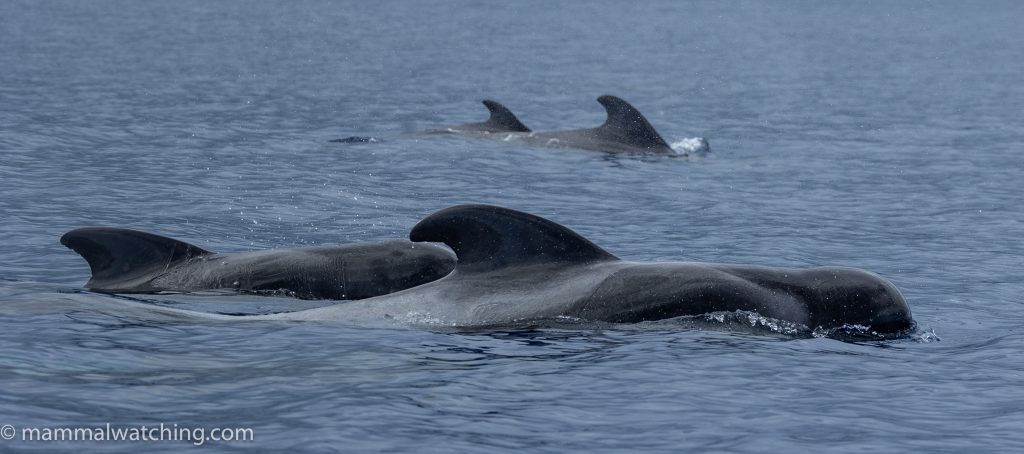
Short-finned Pilot Whale (Globicephala macrorhynchus)
We seldom travelled more than 10 minutes without spotting animals. The water gets very deep very quickly so the oceanography is perfect and the visibility was also outstanding. Whales could clearly be seen swimming under the surface for example.
The whalewatching setup is also pretty cool. The operators rely on instructions over the radio from land-based lookouts (“vigias”) to find the whales. Each vigia sits in a tower with high powered binoculars searching for whales, a relic of the whaling days. I hoped to visit a tower but did not get around to it. Jonas and Ruta did. The vigia they met was happy to show them around and answer questions when he wasn’t working. But he would not be distracted when the boats were out looking for whales.
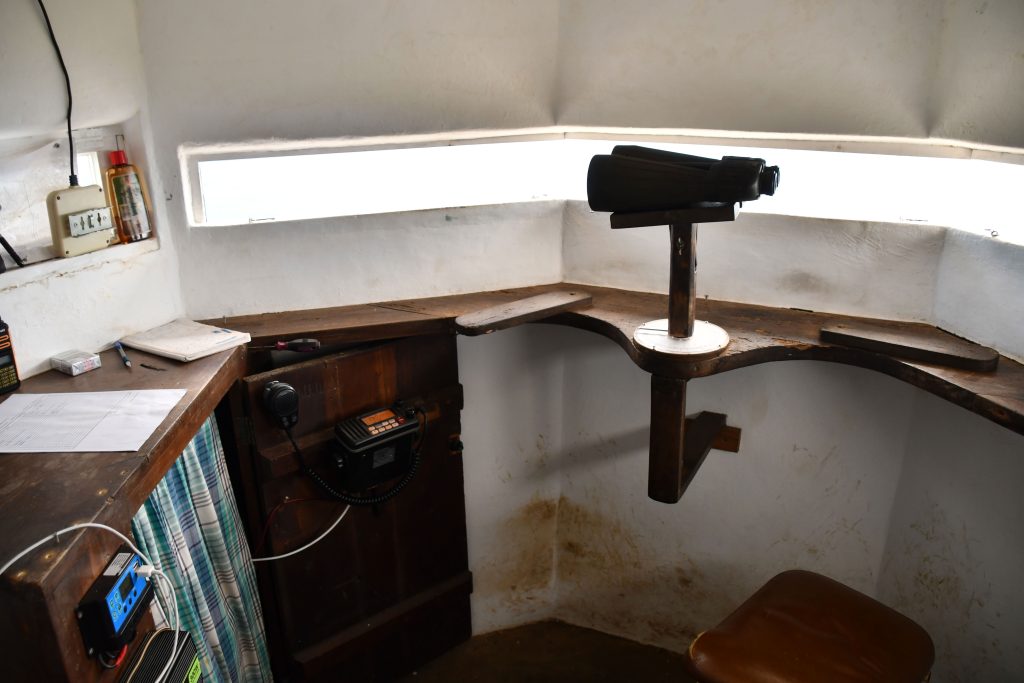
Vigia lookout. Photo Jonas Livet.
Cecking with the vigias and searching from land with a spotting scope ought to offer decent chances for seeing beaked whales and kogia in good conditions. Probably better chances than being out on a zodiac I reckon. I believe the vigias saw these species more often than the boat captains, mainly because the animals are shy and/or only at the surface for a short interval of time and so are rarely targeted for the tourists. That said it would be near impossible to be sure of the exact species from land. There are several species of mesoplodon beaked whales there and Kogia sima has been recorded, albeit rarely, off of Pico.
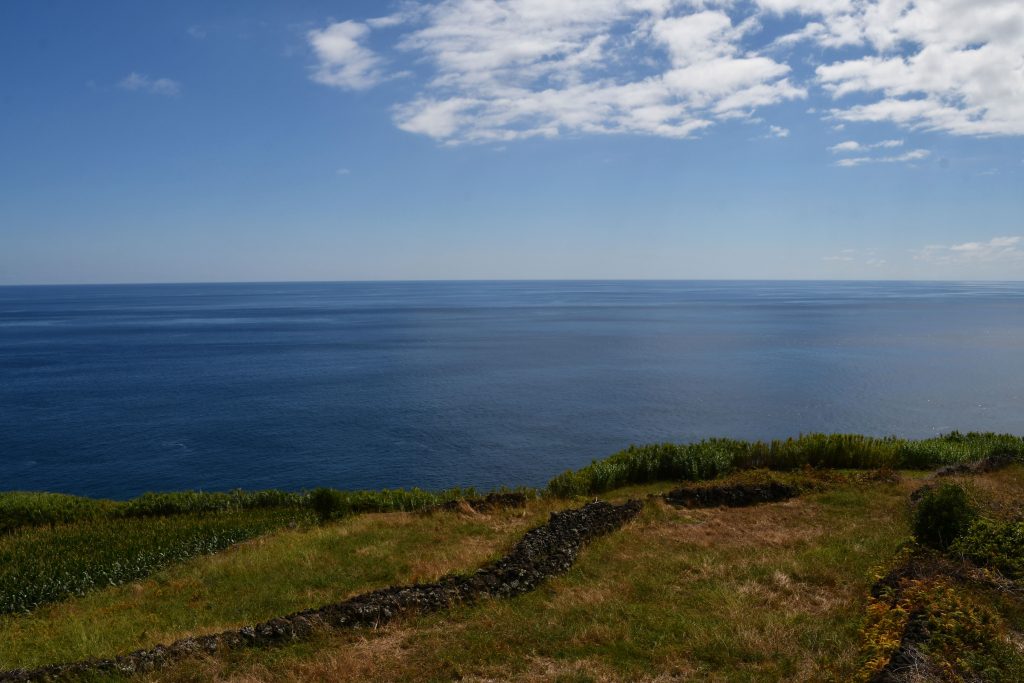
Vigia;s view. Photo Jonas Livet.
We were very impressed with Espaco Talassa, and not because of the quality of the sightings they delivered. Their guides and captains were friendly, engaging, fun and knowledgeable. They were super considerate of the animals and at no time did we feel that the cetaceans were under any stress. Our boat captain was skilled at putting us into positions that would allow the animals to approach us if they chose to. And they often did.
This very young Sperm Whale – possibly only a few days old – swam right under our Zodiac, perhaps because it confused our boat for its mother. It literally scraped under the boat, realised its mistake, and swam off to find mum, part embarrassed, part shocked. Like three year old me grabbing an adult hand in a store and looking up to discover she was not my mother. Here is a video (of the baby whale not toddler me).
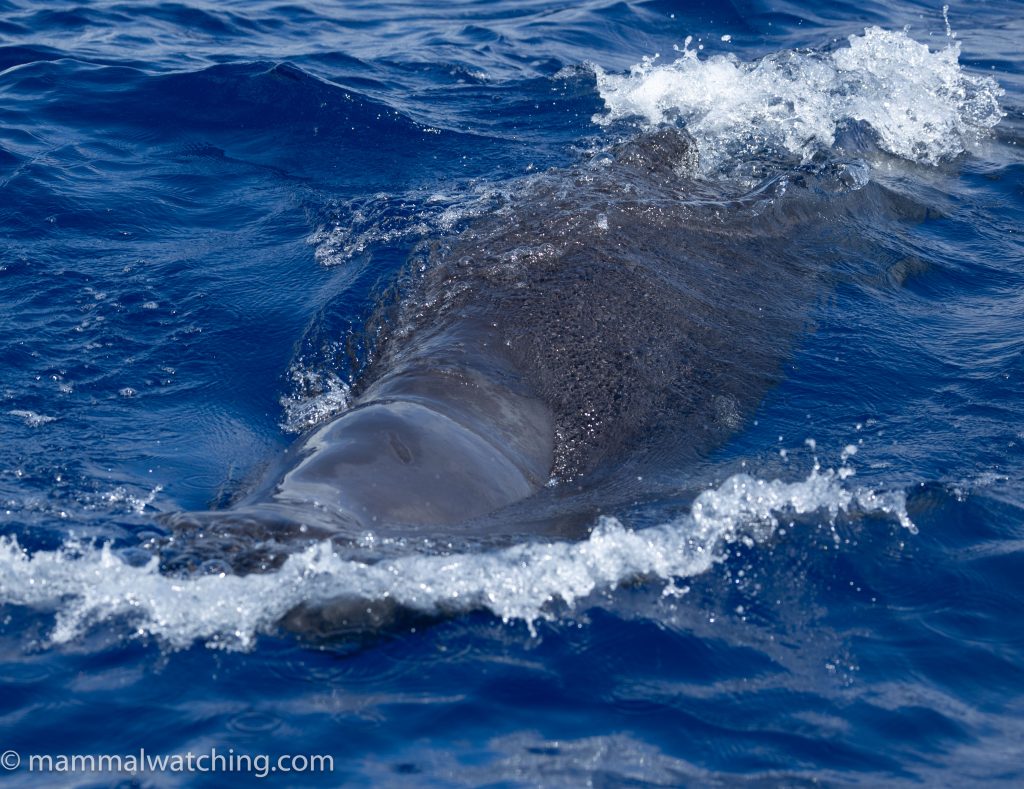
Baby Sperm Whale (Physeter macrocephalus)
Jonas and I talked about renting a car. But rental cars are hard to come by and expensive. Plus we did not need one. There are good places to scan from shore very close to the village, and the vigia tower is only a 30 minute walk (or 4 euro taxi ride) away.
The Mammals
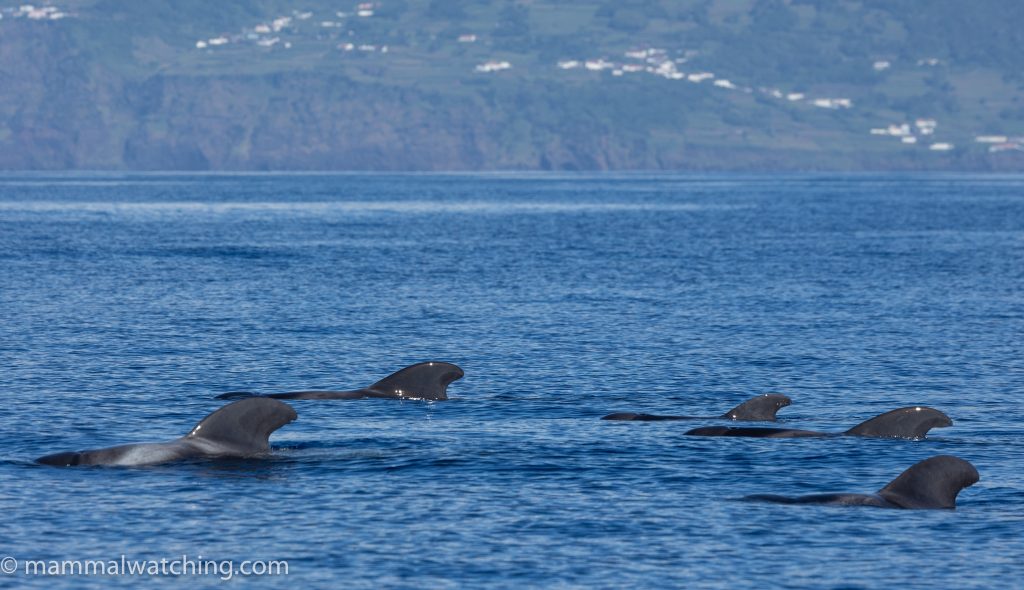
I was at sea for about 20 hours during six trips across four days. We recorded 12 species of cetacean.
Sei Whale (Balaenoptera borealis)
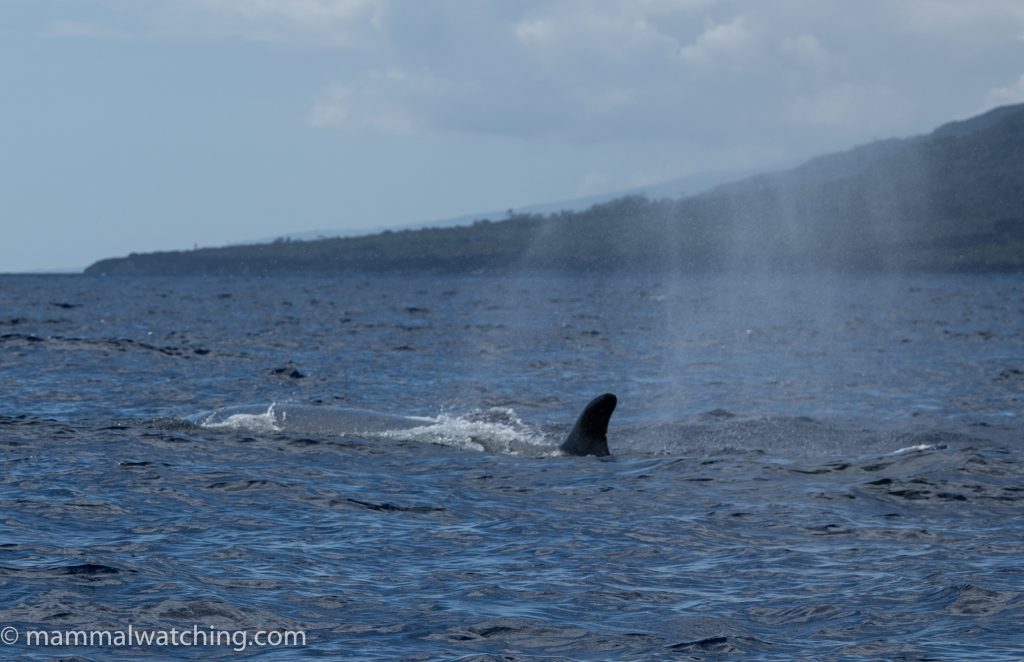
Sei Whale (Balaenoptera borealis)
Just one Sei Whale. Only the second time I have seen the species (the last time was in 2013 off of Cape Cod, Massachusetts). You need to see these whales well to be sure of the ID as Bryde’s Whales are similar. Joao wasn’t happy to record this as a Sei until he had clearly seen the number of ridges on the animal’s snout (a Sei has one ridgeline, while Bryde’s Whales have three).
Bryde’s Whale (Balaenoptera brydei)
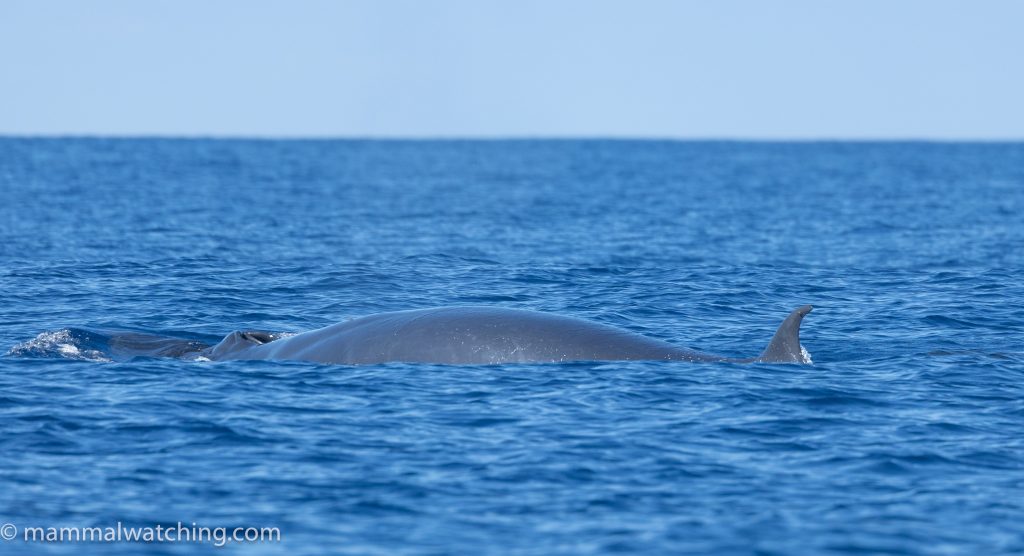
Bryde’s Whale (Balaenoptera brydei)
Two Bryde’s Whale sightings on different days. The Azores are about as far north as this whale ventures in the Atlantic.
Common Dolphin (Delphinus delphis)
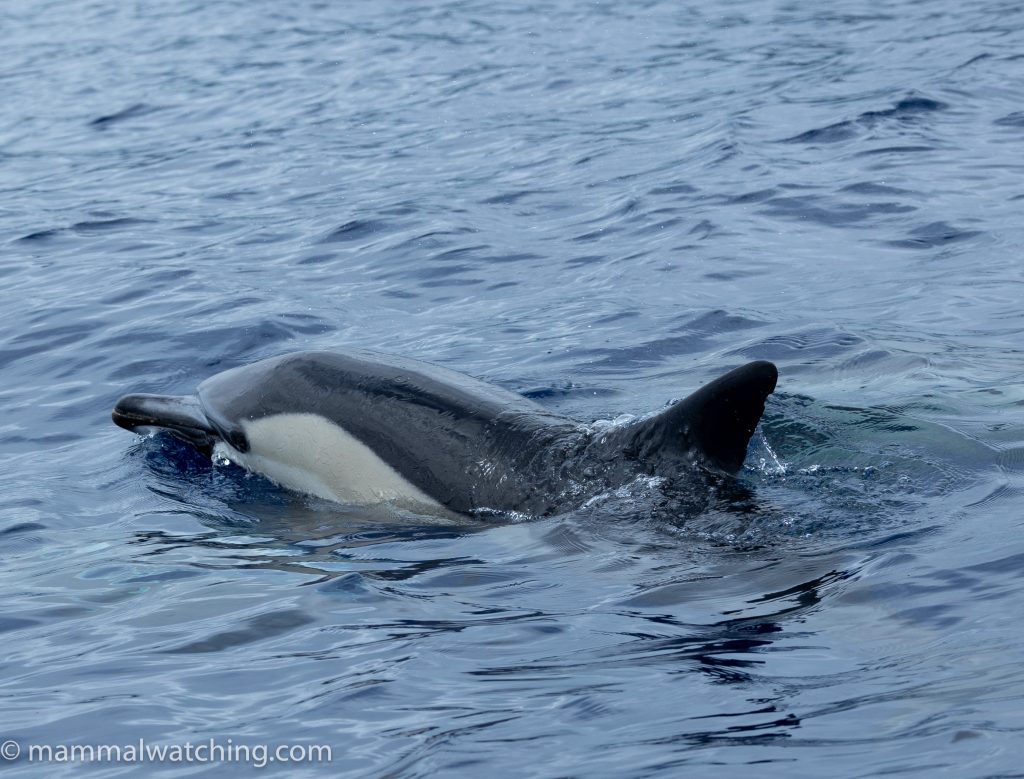
Common Dolphin (Delphinus delphis)
Seen on all six trips.
Striped Dolphin (Stenella coeruleoalba)
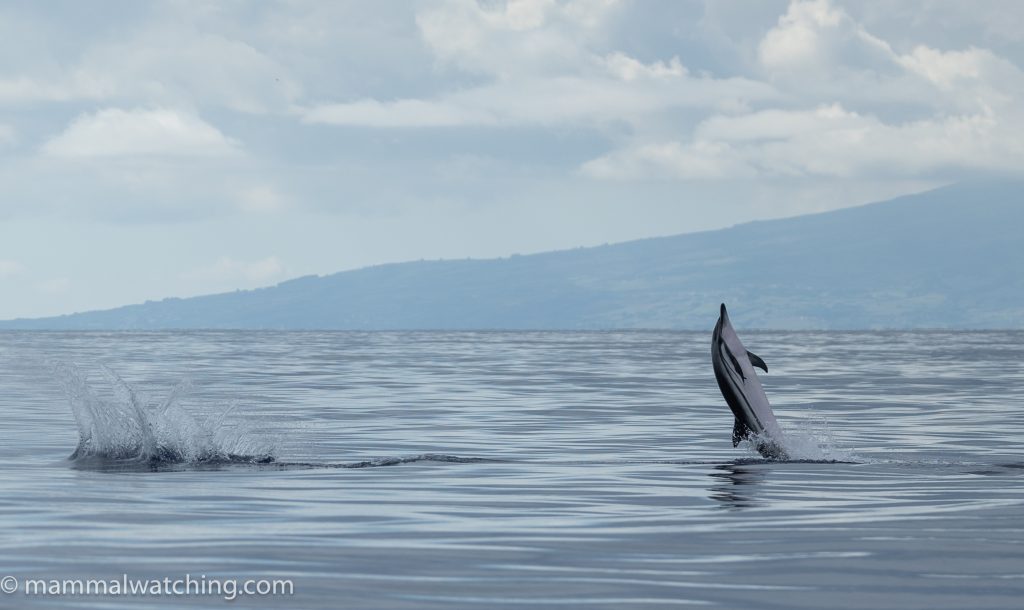
Striped Dolphin (Stenella coeruleoalba)
We saw a large pod late one afternoon. These attractive dolphins were particularly energetic and put on quite a display (a short video is here).
Atlantic Spotted Dolphin (Stenella frontalis)
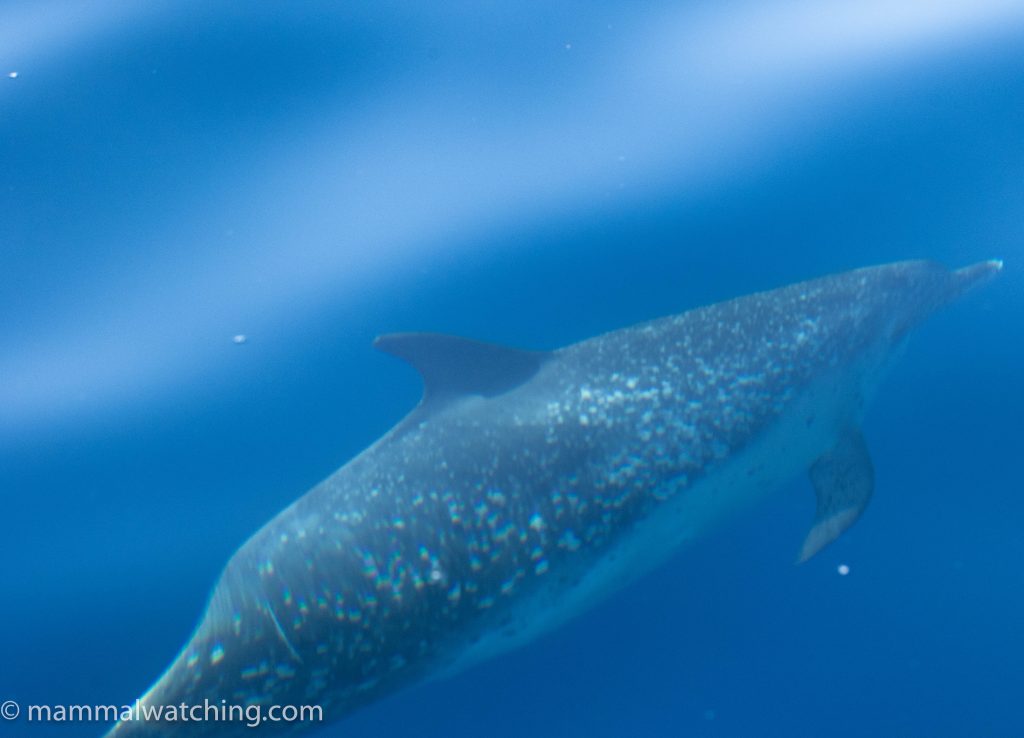
Atlantic Spotted Dolphin (Stenella frontalis)
Spotted Dolphins were the most commonly observed cetacean and we saw them on every trip. They seemed to enjoy coming in close to the Zodiac to spend time bow riding or just chilling at the side of the boat. I had only seen this species once before off of Cape Hatteras, North Carolina.
Common Bottlenose Dolphin (Tursiops truncatus)
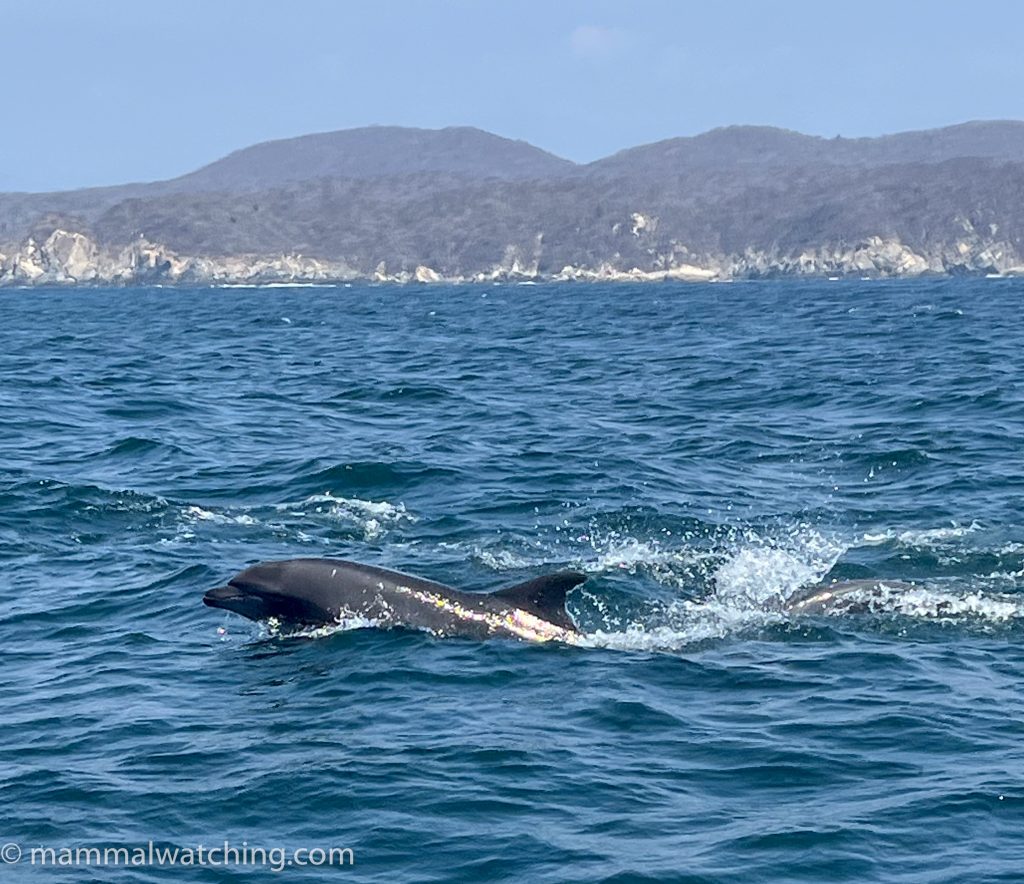
Common Bottlenose Dolphin (Tursiops truncatus)
We had pods of Bottlenose Dolphins on three of my six trips.
Short-finned Pilot Whale (Globicephala macrorhynchus)
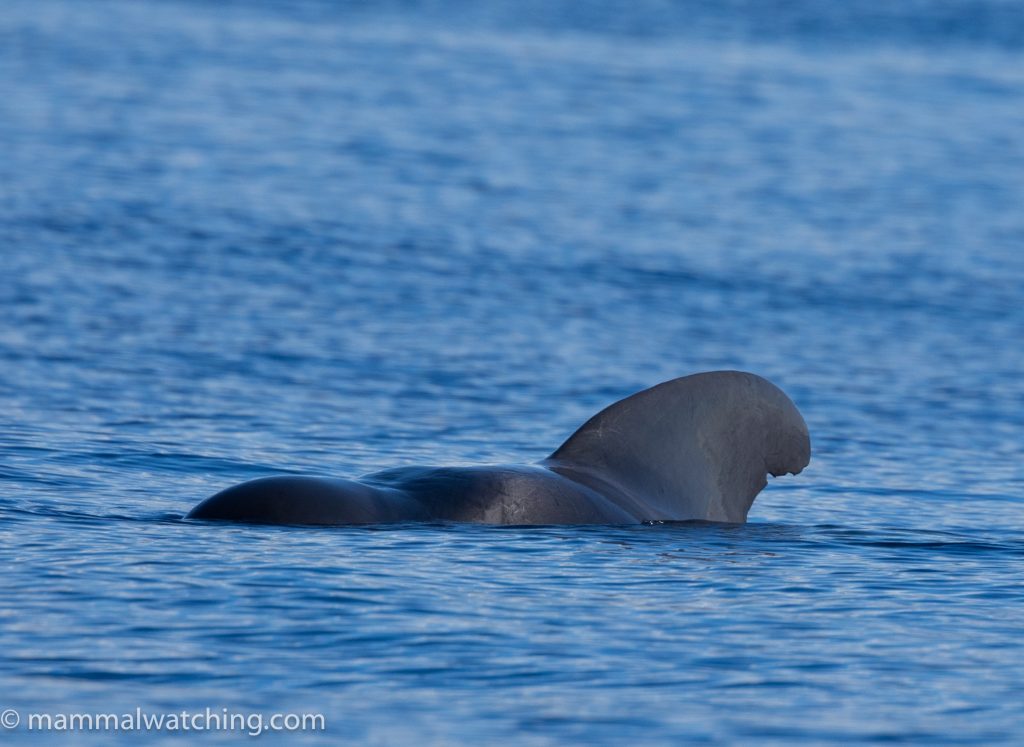
Short-finned Pilot Whale (Globicephala macrorhynchus)
I was happy to be able to spend quality time with several pods of Short-finned Pilot Whales, which we recorded on three of our six trips. Long-finned Pilot Whales also occur here occasionally in the colder months but Joao explained several features to tell them apart.
Risso’s Dolphin (Grampus griseus)
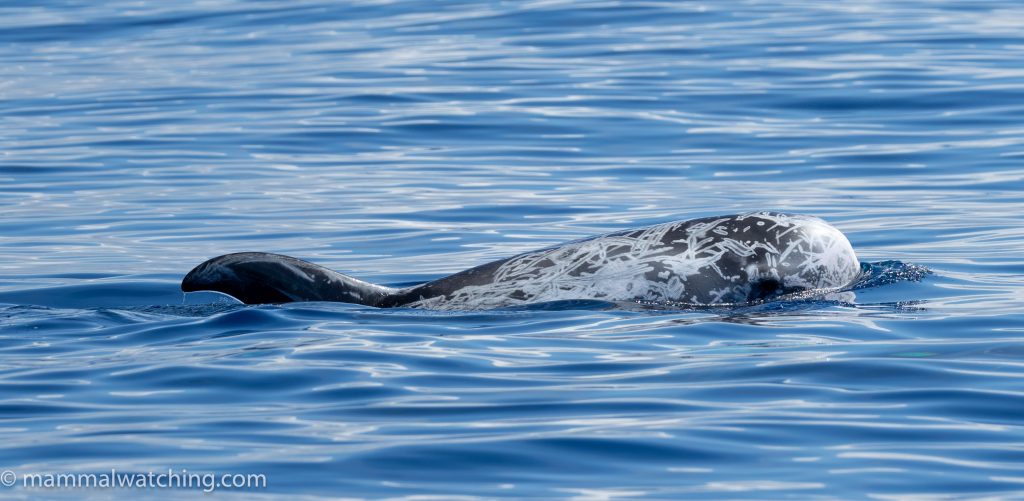
Risso’s Dolphin (Grampus griseus)
Large pods seen very well on every trip. Risso’s really are spectacular dolphins and are now officially Katy Hall’s favourite mammal.
Pygmy Sperm Whale (Kogia breviceps): Lifer
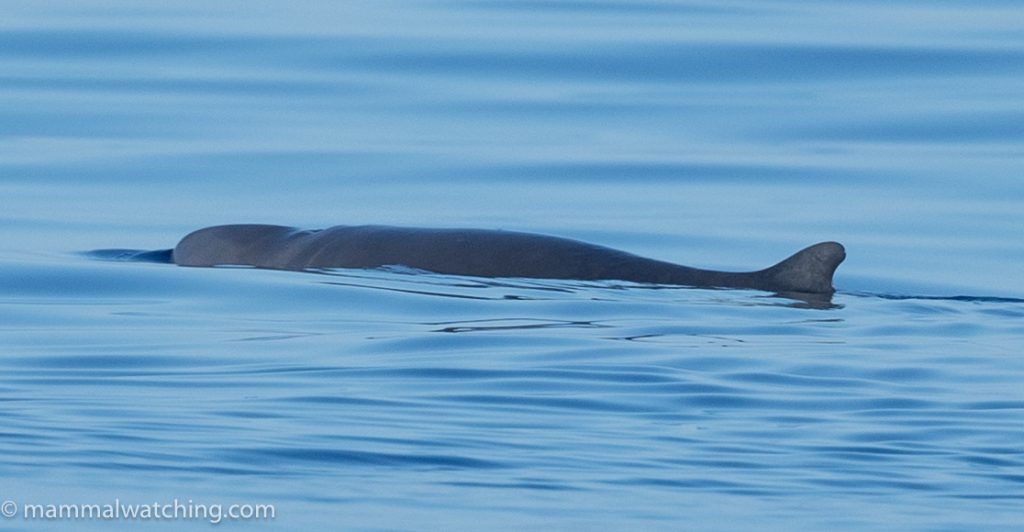
Pygmy Sperm Whale (Kogia breviceps)
My highlight of the week. We saw one distantly on our first morning, and then had a pod of animals at close range for several minutes the following morning. On both occasions the vigia put us onto their presence and I suspect that Joao made a special effort to find them because he had Jonas, Ruta and me on board quivering with excitement. On another day the vigia reported seeing animals but we were unable to locate them.
I knew there was a very slim chance for Pygmy Sperm Whale: Joao posted about seeing one in July. But in reality I had written them off as a very distant possibility. Joao sees them only once or twice a year, if that. Indeed Hella Martens told me she had guided for Espaco for five years and never seen one! So it would require exceptional weather and a lot of luck. We had both.
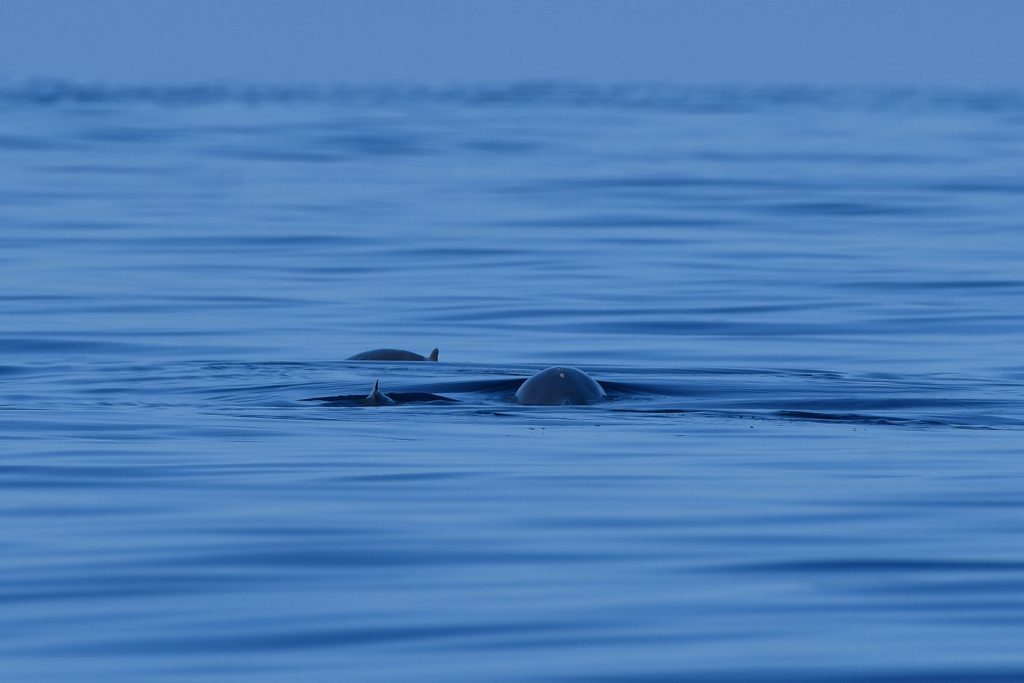
Pygmy Sperm Whale (Kogia breviceps). Three of five animals in a pod. Photo Jonas Livet.
This was the largest ood (5 animals) that Joao had ever seen so that was also notable. The vigia spot this species more often than the boats can find them. In part because most passengers are not as interested in kogia as we were, and in part because they are typically a shy species that will slip away if they sense an approaching boat. I’d not seen either Dwarf or Pygmy Sperm Whale prior to May 2024 (in Baja Sur, Mexico), so to complete the set three months later felt pretty good!
Sperm Whale (Physeter macrocephalus)
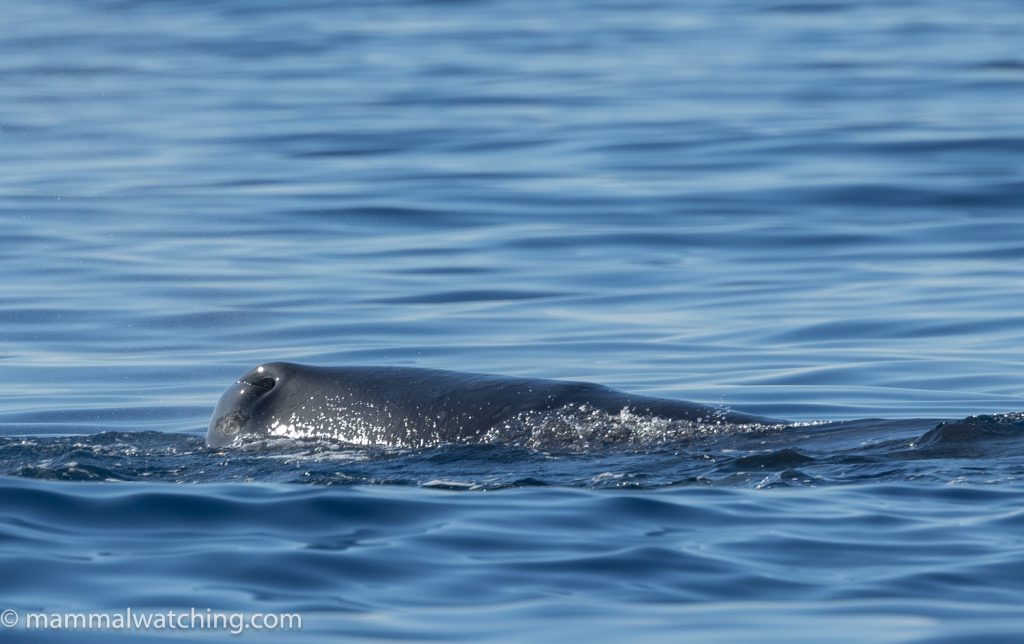
Sperm Whale (Physeter macrocephalus)
The Azores’ resident Sperm Whales are the stars of the whalewatching industry. We saw multiple animals on every trip and if there is one species the boats make a particular effort to find it is this one. Most of the animals we encountered were pods of females with young, but we also saw two bachelor pods. The males are noticeably larger. We saw one animal spy hopping – from a distance – and had this a very young whale (see the video ) go right under our zodiac.
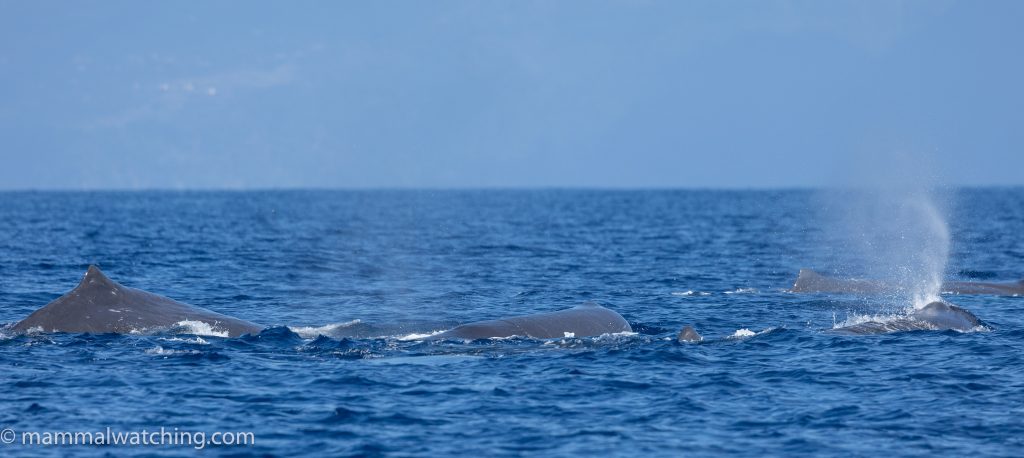
Male Sperm Whales (Physeter macrocephalus).
Sowerby’s Beaked Whale (Mesoplodon bidens): Lifer
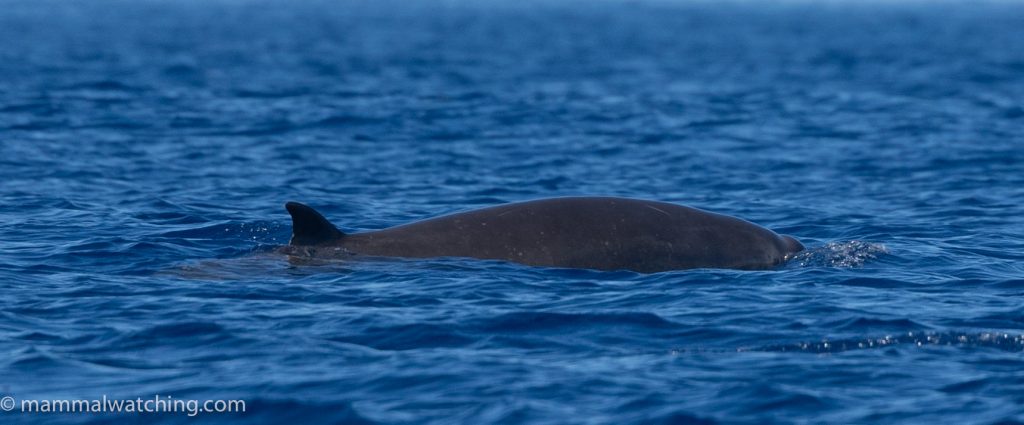
Sowerby’s Beaked Whale (Mesoplodon bidens)
I was inspired to visit the Azores because of the chance for Sowerby’s Beaked Whales and we saw them twice on separate days. They can be hard to differentiate from other mesoplodon whales, such as True’s and Gervais, which are also seen occasionally. But the team there are familiar with Sowerby’s and were confident of both our sightings. In particular when Sowerby’s Beaked Whales surface they lift their beak out of the water which, we were told is an important diagnostic feature for the species. That behaviour is well shown in Jonas’s picture below and in this brief video. They seem to be relatively common in July and August, but you need flat seas to spot them.
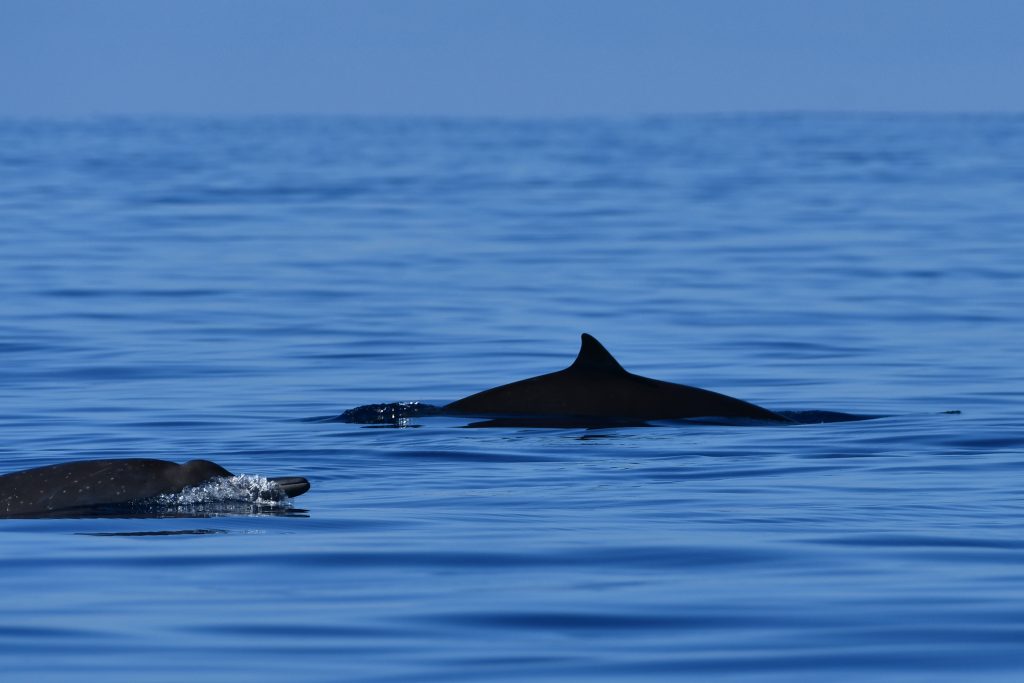
Sowerby’s Beaked Whale (Mesoplodon bidens) surfacing and raising its beak. Photo Jonas Livet.
Cuvier’s Beaked Whale (Ziphius cavirostris)
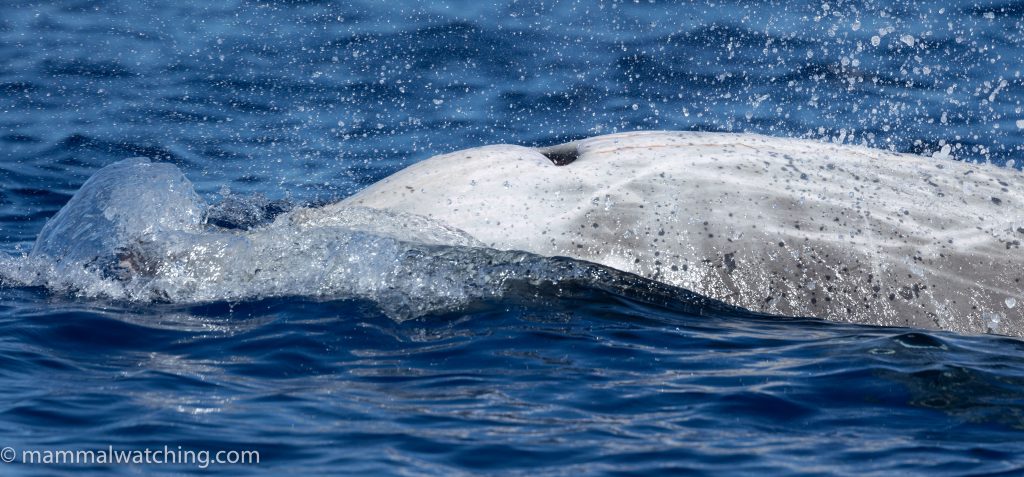
Cuvier’s Beaked Whale (Ziphius cavirostris)
Another species that is rarely seen here. We had a pod of animals during our 10 species mega-morning on our second day. They came in fast and very close to the zodiac (too close for my lens!) and the animal below appeared to be an albino. This was only the second time I had seen this species (the other time was corssing the Bay of Biscay 30 years ago).
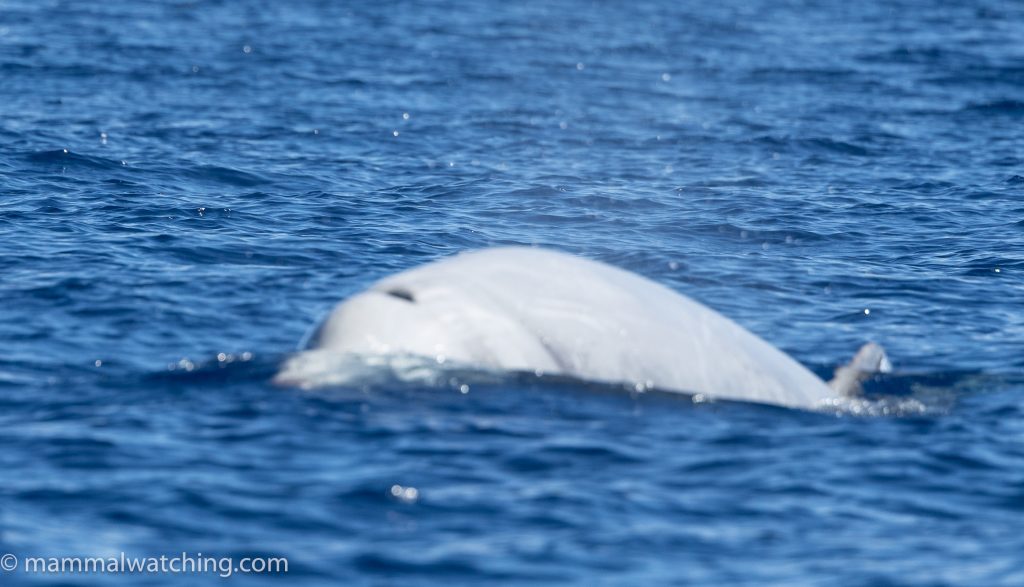
Albino (?) Cuvier’s Beaked Whale (Ziphius cavirostris)
Azores Noctule (Nyctalus azoreum) (endemic): Lifer
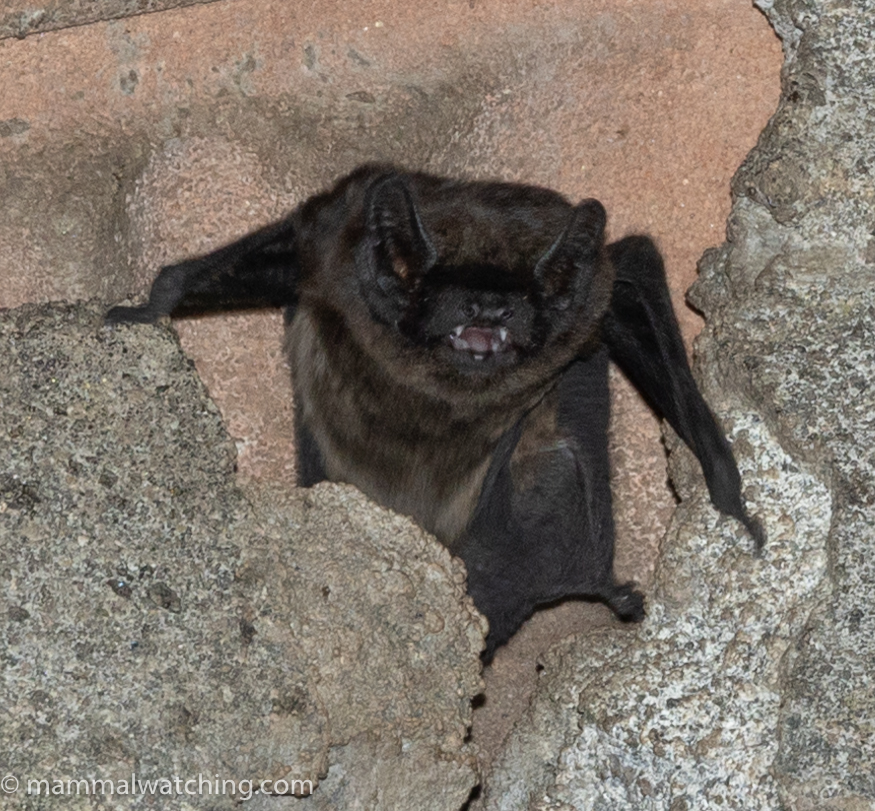
Azores Noctule (Nyctalus azoreum)
This endemic bat, the only species in the Azores, is easy to observe at dusk in Lajes do Pico. Jonas and Ruta discovered a roost in an abandoned house’s roof more or less here .. just walk about the alley at sunset and look for bats (here is a video). We saw them flying around lights in the village too, while Jonas and Ruta saw them flying well after sunset when they drove to the north of the island. Jonas also discovered an accessible cave roost in the Ponta Delgada botanic gardens (his report is here).
Final Thoughts and Thanks
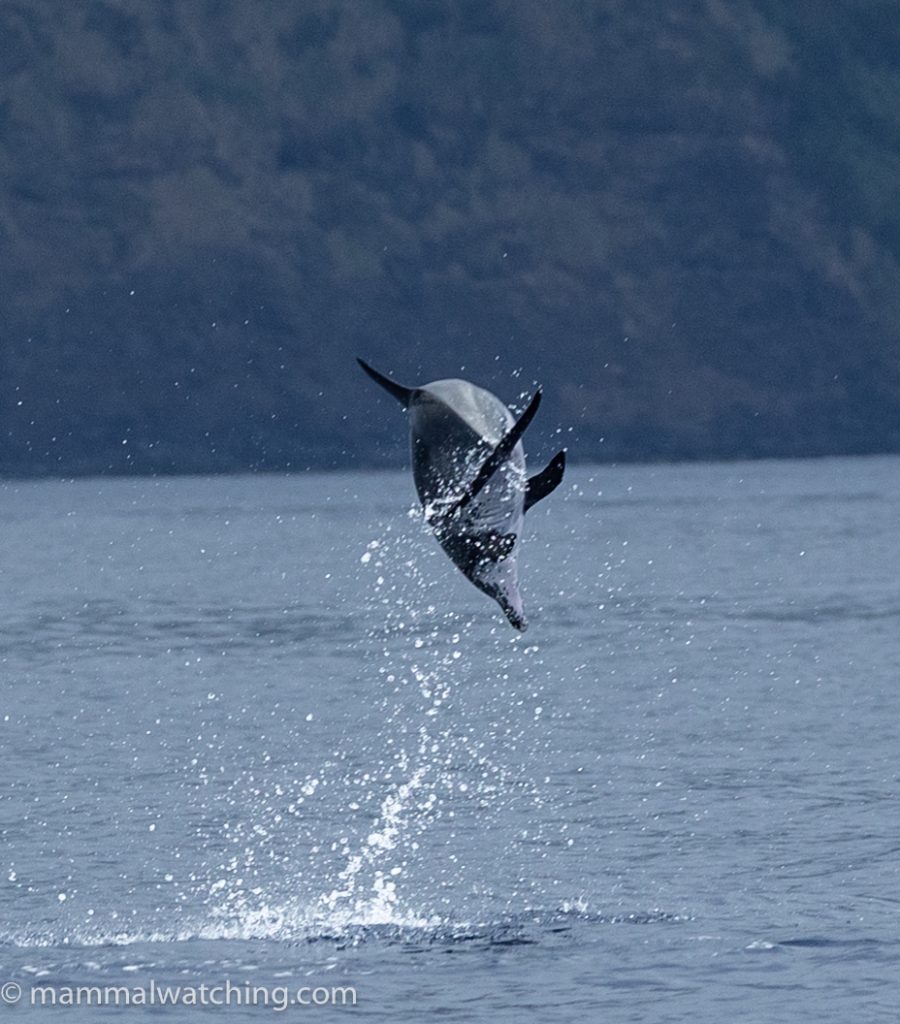
Atlantic Spotted Dolphin (Stenella frontalis)
A great week in a great place. We were super impressed with the Espaco Talassa operation, and the quality of their guides and crew. The Pico whalewatching is world class and must surely be the best in Europe. But there is no doubt we were also exceptionally lucky, in part helped by the perfect weather, by the enthusiasm of the crew who had fun when they knew what we were chasing, and maybe a little something from my lucky hat!
But as you can see from Joao’s post he delivered us his best morning in 26 years. So Pico is great but maybe not usually quite this great!
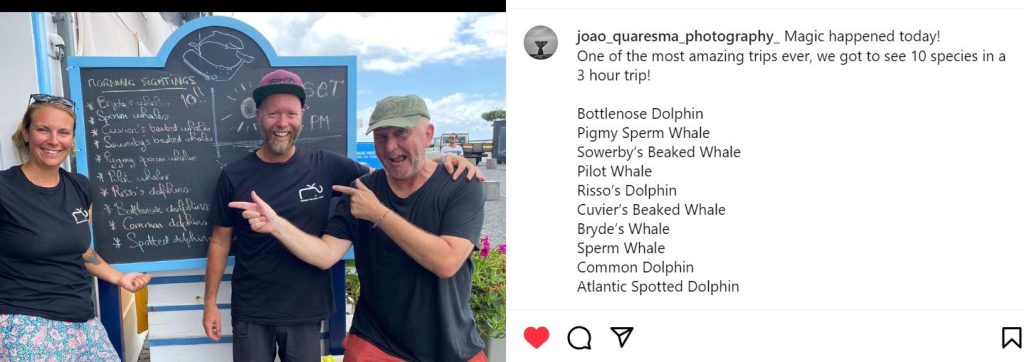
My thanks to Todd Pusser and Bob Pitman for the initial inspiration (and to Ava Meyer too!). To Adam Walleyn for introducing me to Hella Martens, and to Hella for taking the time to give me some detailed advice. And a very big obrigado to Joao Quaresma and the great guides – the entire team in fact – at Espaco Talassa. I like to think they enjoyed the challenge of finding us our lifers! Katy and I were glad that Jonas and Ruta joined us – good company and great spotting – and my own thanks to Katy Hall for suggesting we should go in the first place. Yes, Katy, you really did.
Stuff We Missed
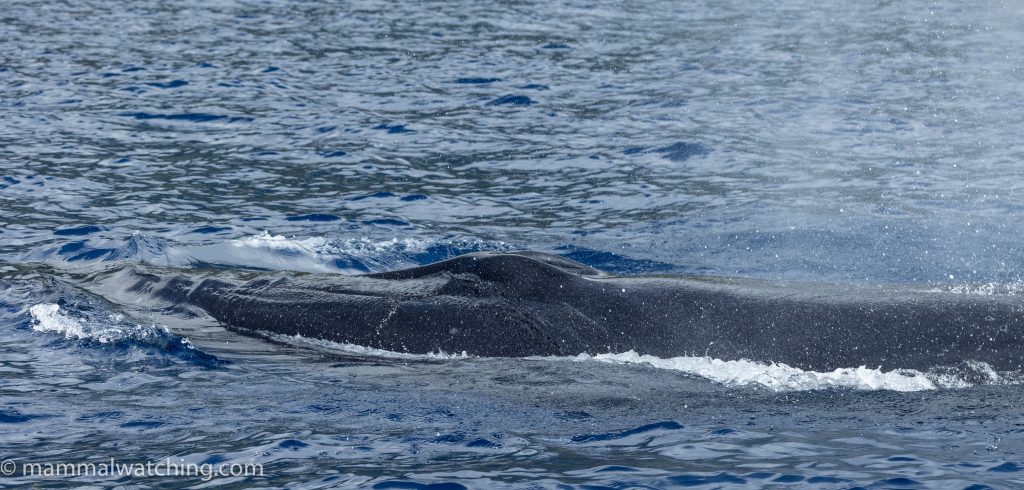
Bryde’s Whale (Balaenoptera brydei)
We saw 12 species of cetacean. Looking at the August and July data from Espaco Talassa they recorded 14 species in total over the two months. The two we missed were one sighting of a Blainville’s Beaked Whale and a handful of False Killer Whale sightings. The latter is the one species we might have reasonable expected to see. So we didn’t miss much. There is a slim to very slim change of True’s and Gerais’ Beaked Whales in August and it is worth remembering that beaked whale sightings are more often recorded as ‘Mesoplodon sp. so there is a more of a chance for these other mesoplodon species than the data suggest.

Striped Dolphin (Stenella coeruleoalba)
Post author


Leave a Reply
You must be logged in to post a comment.